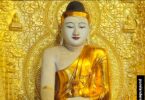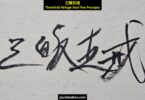 Buddha Recitation with a Rosary
Buddha Recitation with a Rosary
With this method, the rosary is fingered with each recitation of the Buddha’s name. The word ‘Amitabha’ (Amituofo) may be recited, rather than the long formula ‘Namo Amitabha Buddha’ (Namo Amituofo), as it is very easy to achieve singlemindedness with the shorter expression. You can finger the rosary upon the first or third syllable of the word “Amitabha” (Amituofo), but whichever you decide, you should stick to it and not make mistakes. This is the method of using the rosary to focus the mind.
Commentary: The purpose of fingering the rosary is to achieve singlemindedness – each recitation following the previous one without a single intervening delusive thought. It is as though all the beads are glued together without a single gap. Moreover, such recitation is a skillful means of reminding beginners who have not yet achieved correct thought to focus on the Buddha’s name. Through this method, the indolent can become industrious, the dilatory can redouble their efforts and strive harder. When correct thought is achieved, the Buddha’s name does not leave the mind – at that time, whether or not one uses a rosary no longer matters. Therefore, practitioners of limited good roots need this method as an expedient. Otherwise, there is no use buying a rosary and letting it gather dust.
Reciting Aloud
When your mind is in a state of torpor or when delusive thoughts arise unchecked, compose yourself and recite the Buddha’s name aloud a few hundred times. You will then naturally experience a pure, peaceful state. This is because the faculty of hearing is very keen and therefore people are easily influenced by external factors which disturb the mind and lead to errant, delusive thoughts. Thus, you need to recite aloud to control the faculty of hearing and enlighten the mind. When the mind hears only its own sounds, each sound in its totality following upon the one before, all thoughts of right and wrong, what should and should not be done, are naturally abandoned.
Commentary: When we are exhausted and sluggish, we tend to doze off or feel as if something were pressing on both body and mind. If we engage in pure, silent recitation at such times, our lethargy can only increase. Therefore, it is better to recite aloud, pondering that the Buddha’s name originates from the Self-Mind and returns to the Self-Mind through the ears in an unending circle. We should continue to practice in this manner until the mind clears up, the demon of drowsiness disappears and only Buddha Recitation remains, clear and distinct. Only then should we stop.
Buddha Recitation in a Low Voice
When the mind is scattered, or when you are tired and weighed down by many pressing tasks, you need not recite aloud. You need only focus your mind and thoughts and recite carefully in a low voice. Only when your breath returns to normal, your spirits rise, and your mind is calm and at peace, should you recite aloud.
Commentary: The purpose of reciting the Buddha’s name in a low voice is to treat the disease of scattered mind. There are times when the volume and pressure of work or other demanding activities make mind and body overburdened and weary. At these times, it is better to recite in a low voice, as reciting aloud can only add fuel to the fire and increase the power of the demon of scattered mind. To recite in a low voice, with each word, each sentence clearly and carefully enunciated, gradually settles the mind. When that point is reached, one can then recite aloud.
Diamond Recitation
If the mind is agitated and the breath uneven, something is bothering you, or reciting the Buddha’s name either aloud or in a low voice is inconvenient, you should just move your lips, practicing silent recitation (Diamond Recitation). With this method, the number of recitations does not matter; the essential condition is that each word, each recitation should come from the mind.
Commentary: (Note: In this Diamond Recitation method, it is without sound, though some systems might use sound.) The Diamond method differs from recitation in a low voice in that the lips move but no sound is heard. This method is useful when our sleeping or living quarters are close to someone else’s. In such circumstances, reciting in a loud or a low voice might disturb them. We should then just move our lips and practice Diamond recitation. The number of recitations does not matter as long as the Buddha’s name originates in the Self-Mind, moves the tip of the tongue and produces a sublime sound. Even though the sound is not audible, it reverberates throughout the Dharma realm (cosmos) while remaining part of the current recitation.
Silent Recitation
There are instances when it is not appropriate to recite either aloud or in a low voice. There are times when it is awkward to finger a rosary. There are still other times when even Diamond Recitation may be inappropriate. (This is because Diamond Recitation, while silent, still involves moving the lips.) For such instances, the ancients have devised an excellent expedient. It is not to move the lips, not to utter a sound, but merely to concentrate mind and thoughts on recitation, silently touching the upper front teeth with the tongue, or alternatively, to visualize this action. The only condition is that the Buddha’s name be clear and distinct, though it is uttered not from the mouth but from the Self-Nature. The faculty of hearing and the inner mind interpenetrate, the inner mind is stamped on the tip of the tongue, the tip of the tongue pulls along the faculty of recitation, the faculty of hearing hears the Self-Nature – the three (inner mind, hearing, recitation) form one unit. Recitation interpenetrates with recitation – in time the visualization of “everything as Mind-Only” is realized.
Commentary: This silent recitation method, when used to perfect the visualization of Mind-Only is somewhat difficult and is a high-level practice. It is reserved for the most part for those advanced along the path of cultivation. The cultivator must employ ‘visualization-mind’ not recitation-thought. He does not move his lips, yet the sound is clear and distinct. It is the sound of the Self-Nature. This is the method of “reverting the faculty of hearing to hear the sound of the Self-Nature. To perfect such recitation is to penetrate the true nature of all dharmas, to penetrate the truth that everything is made from Mind alone.
From ‘Taming the Monkey Mind: A Guide to Pure Land Practice’
(48 Ways to Be Mindful of Buddha) By Buddhist scholar Cheng Wei-An
Translated with Commentary by Elder Master Suddhisukkha
http://www.ymba.org/monkey/monkyfrm.htm
Related Article:
Should I Chant Loudly, Silently or In Between?
https://purelanders.com/2009/09/15/should-i-chant-silently-loudly-or-in-between/




